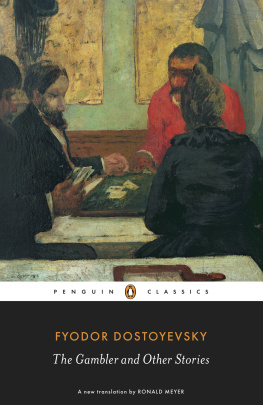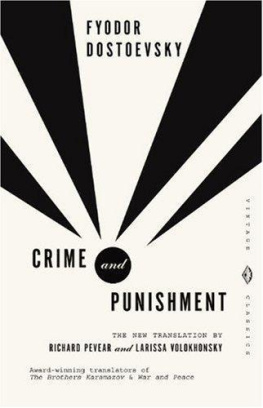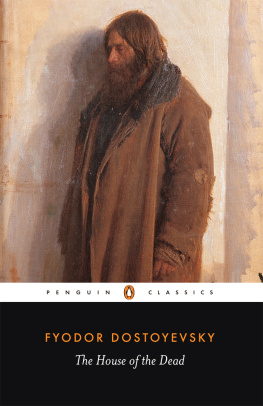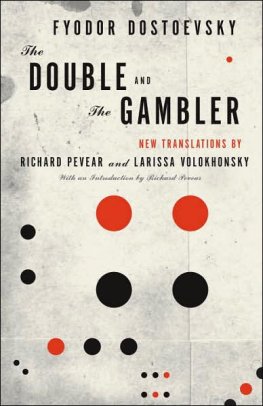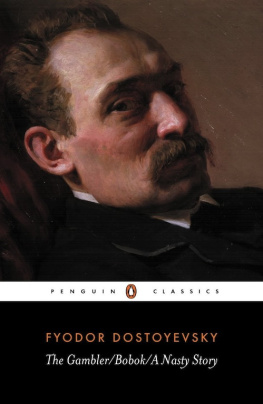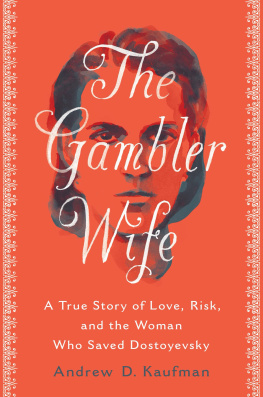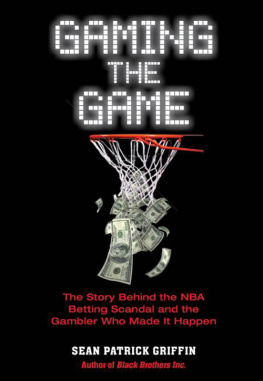
THE GAMBLER, BOBOK and A NASTY STORY
FYODOR MIKHAILOVICH DOSTOYEVSKY was born in Moscow in 1821, the second of a physicians seven children. His mother died in 1837 and his father was murdered a little over two years later. When he left his private boarding school in Moscow he studied from 1838 to 1843 at the Military Engineering College in St Petersburg, graduating with officers rank. His first story to be published, Poor Folk (1846), was a great success. In 1849 he was arrested and sentenced to death for participating in the Petrashevsky circle; he was reprieved at the last moment but sentenced to penal servitude, and until 1854 he lived in a convict prison at Omsk, Siberia. In the decade following his return from exile he wrote The Village of Stepanchikovo (1859) and The House of the Dead (1860). Whereas the latter draws heavily on his experiences in prison, the former inhabits a completely different world, shot through with comedy and satire. In 1861 he began the review Vremya (Time) with his brother; in 1862 and 1863 he went abroad, where he strengthened his anti-European outlook, met Mlle Suslova, who was the model for many of his heroines, and gave way to his passion for gambling. In the following years he fell deeply in debt, but in 1867 he married Anna Grigoryevna Snitkina (his second wife), who helped to rescue him from his financial morass. They lived abroad for four years, then in 1873 he was invited to edit Grazhdanin (The Citizen), to which he contributed his Diary of a Writer. From 1876 the latter was issued separately and had a large circulation. In 1880 he delivered his famous address at the unveiling of Pushkins memorial in Moscow; he died six months later in 1881. Most of his important works were written after 1864: Notes from Underground (1864), Crime and Punishment (18656), The Gambler (1866), The Idiot (1869), The Devils (1871) and The Brothers Karamazov (1880).
FYODOR DOSTOYEVSKY

The Gambler, Bobok and A Nasty Story

TRANSLATED
WITH AN INTRODUCTION BY
JESSIE COULSON
PENGUIN BOOKS
PENGUIN BOOKS
Published by the Penguin Group
Penguin Books Ltd, 80 Strand, London WC2R 0RL, England
Penguin Putnam Inc., 375 Hudson Street, New York, New York 10014, USA
Penguin Books Australia Ltd, 250 Camberwell Road, Camberwell, Victoria 3124, Australia
Penguin Books Canada Ltd, 10 Alcorn Avenue, Toronto, Ontario, Canada M4V 3B2
Penguin Books India (P) Ltd, 11 Community Centre, Panchsheel Park, New Delhi 110 017, India
Penguin Books (NZ) Ltd, Cnr Rosedale and Airborne Roads, Albany, Auckland, New Zealand
Penguin Books (South Africa) (Pty) Ltd, 24 Sturdee Avenue, Rosebank 2196, South Africa
Penguin Books Ltd, Registered Offices: 80 Strand, London WC2R 0RL, England
www.penguin.com
This translation first published 1966
26
This translation copyright Jessie Coulson, 1966
All rights reserved
Except in the United States of America, this book is sold subject
to the condition that it shall not, by way of trade or otherwise, be lent,
re-sold, hired out, or otherwise circulated without the publishers
prior consent in any form of binding or cover other than that in
which it is published and without a similar condition including this
condition being imposed on the subsequent purchaser
EISBN: 9780141907956
CONTENTS
INTRODUCTION
IN September of 1866, Fyodor Mikhailovich Dostoyevsky was faced with what seemed an impossibly difficult task: he had to write a complete new novel for delivery to the publisher Stellovsky by 1 November, or lose his only profitable source of livelihood. The payments he received from the proprietors of the magazines in which his writings were first published had never been very great, but once a writer was established, much more could be hoped for from subsequent editions in book form. In the previous year Dostoyevsky had been forced by pressure from his creditors to sell Stellovsky the right to produce a collected edition, in three volumes, of all his previous works. The price of 3,000 roubles Stellovsky paid for the privilege was to include a new book of not less than ten printed sheets (160 pages); in the event of failure to fulfil this part of the contract he was to be given the right to reprint all Dostoyevskys past and future work at any time without further payment. Dostoyevsky always maintained that Stellovsky forced him to accept these terms by buying up his promissory notes from creditors who had expressed their willingness to wait for their money, and then making those creditors insist on immediate payment. Thus he was merely transferring the greater part of the 3,000 roubles to his own pocket.
Dostoyevsky had never learned to handle money wisely or successfully, but he was not really to blame for the desperate situation in which he found himself in 1865. It resulted largely from his unquestioning acceptance of a responsibility he was by no means obliged to take on himself, the responsibility for his beloved brother Michaels widow and young family. Michaels sudden death in July 1864 came at a time when the brothers were struggling to put their new literary and political magazine, the Epoch, on its feet, but the magazine was practically still-born and they had only the remotest chance of success. Their first monthly journal, Time, started by Michael in January 1861, had been both successful and prosperous. Dostoyevsky had thrown himself with enthusiasm into the (unofficial) running of the editorial side, dealing with the contributors and himself writing articles and publishing Memoirs from the House of the Dead and other novels there, while Michael, nominally responsible for the whole magazine, confined most of his attention to the business management of the enterprise. But an article on the Polish rising which appeared in the number for April 1863 was so displeasing to the censors that the magazine was immediately suppressed. What made the disaster overwhelming was that despite all their efforts the brothers could not get permission to resume publication even after several months; instead, too late to advertise for subscribers or bring out the first issue before March, Michael was allowed to start an entirely new magazine in January 1864. He worked like a slave to get the first (double) number out, borrowing to the utmost limits of his credit to pay the contributors, arranging for printing and for supplies of paper on credit, and struggling with the editorial work as well. Fyodor contributed the first part of Memoirs from Underground to this JanuaryFebruary number, but was unable to help in any other way: from November 1863 onwards he was in Moscow, unable to leave the bedside of his sick wife Masha, who died of consumption on 15 April 1864. At the end of the month he returned to St Petersburg and tried to take some of the burden from Michael, whose health, never very robust, had suffered severely from all the strains and anxieties of the past year. Michael, however, continued to drive himself as hard as ever, and when he too died less than three months later his family was convinced that it was the



